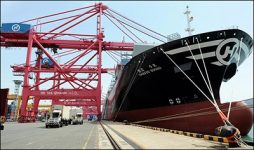
Hanjin Xingang uses RFID technology to speed up truck loading and unloading
[ad_1]
Hanjin Newport Corporation (HJNC) is using UHF RFID solutions to help manage the entry and exit of vehicles at Busan’s deep-water port. The RFID solution is provided by the Korean company Qbit, using Qbit’s software, Mojix STAR RFID receiver and eNode transmitter to read the entry and exit of vehicles at the port.
HJNC Port was built in 2010 and can hold 2 million standard containers. It is a logistics hub in Northeast Asia. The port is a joint venture between HJNC and the Port of Singapore Authority.

HJNC can handle these businesses partly because of the RFID Port Operation System (TOS). Using this system, port gates and cargo areas can recognize vehicle entry and transmit the data to the automatic rail-mounted gantry crane (RMGC) system. In this way, the crane will quickly unload or load these cargo containers.
Currently, thousands of third-party operators’ trucks and HJNC’s vehicles use this system to receive or unload cargo. Every time a cargo is unloaded or loaded, there will be long lines of vehicles, which is something HJNC should avoid. By quickly identifying vehicle information in the cargo area, the system allows the crane to be ready when the vehicle reaches the designated cargo area.
Before using RFID technology, crane dispatching was one of the challenges faced by ports. When some trucks enter the port gate, they may stop to go to the port to take a bathroom or have a meal, and then drive into the cargo area.
In the past, HJNC has tried to use UHF RFID technology at the gate to identify vehicles. However, the company logo, RFID hardware encountered some problems during the test, and many readers often failed to read the tags on the vehicle. At this time, HJNC employees must manually identify the vehicle and allow the driver to pass the reader inspection again.
Therefore, HJNC contacted Qbit to develop a better solution. Qbit was founded in 2011 and is an RTLS technology company in the industrial sector. Qbit CEO ChongWoo Kim said that the company mainly provides solutions in Asia. He said: “The STAR system is our main solution, and it has been used in many industries.”
Kim said that the STAR system can achieve accurate readings over long distances. The STAR system uses a STAR 3000 receiver and Mojix eNode transmitter to read tags. After the tag receives the signal from the eNode, it will transmit the signal to the receiver, and the system will forward the read data to the STAR Master controller and the back-end server software.
The system was installed in February 2014, and each truck is equipped with a passive EPC Gen2 UHF on the upper side of the windshield RFIDTag (Smartrac DogBone RFID tag).
In Qbit software, each tag ID number and truck company information are bound to each other, and the data is sent to TOS software. The port gate has eight lanes, and only one STAR receiver is used to read RFID tags. Based on this information, Qbit software can determine the truck company and print out a note to the driver to indicate the location of the cargo area.
At the same time, the data will be transmitted to TOS to assign tasks to automatic cranes. When the Qbit software receives the crane’s confirmation instruction, the gate of the loading area will light up with a green light, indicating that the vehicle can enter. When the vehicle passes the gate of the loading area, the system will read the truck tag and prompt that the crane vehicle has entered.
JoongRyun Lim, head of data analysis at HJNC, said that this technology has increased the read rate to 100%. This technology ensures the effective use of cranes and reduces idle time. He explained: “This saves time and electricity bills and serves more vehicles.”
Achieving this goal is not easy, Kim said: “In order to find the best antenna installation location, we have been simulating truck entry and discovery for several months and tested it again and again.”
[ad_2]


